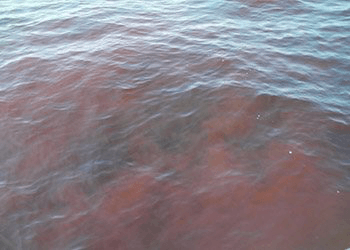Texas Coastal Residents Should Be Ready For Possible Invasion
A Texas A&M University professor has developed a system to detect and possibly predict when the harmful algae invasion might occur.

If it’s autumn in Texas, that means red tide might not be far behind and that’s never good for coastal residents. A Texas A&M University professor has developed a system to detect and possibly predict when the harmful algae invasion might occur.
Lisa Campbell, whose work is funded by NOAA, has studied red tide for years. These large blooms of microscopic algae that appear along the Gulf Coast and produce toxins are a nuisance that can disrupt seafood harvesting and pose a threat to humans, fish, marine mammals, and even birds.
When a red tide event occurs, it is called a harmful algal bloom, and it can affect large areas of the Texas coast. The blooms appear to peak during September and October and can result in huge fish kills and loss of marine life.
“Florida has red tide blooms almost every year, but Texas is often right up there,” Campbell says.
“When a bloom occurs, oyster fishing often comes to a halt to make sure no one eats the shellfish that have high levels of brevetoxins, the toxins which make the red tide harmful. The oysters themselves are not affected by red tide, but people who eat them can become ill. Fish are not so lucky.
“You often see huge fish kills, where dead fish have washed up on the beach. Once that happens, it’s too late to do anything.”
She says manatees and other marine mammals and birds can also be affected by red tide, which is technically called Karenia brevis.
Campbell says it’s now believed that winds play a big role in whether or not a red tide event will occur.
“The direction and intensity of coastal winds seems to play a big part in red tide formation in a particular area,” she adds.
“In 2009 and 2011, the algae blooms were especially severe. We have already detected in recent weeks what may be the early onset of red tide, and the next week or two should tell us if we’ll see a repeat of 2011, when things got pretty bad.”
Campbell uses a system called an Imaging FlowCytobot, which samples sea water every 20 minutes, records images of all the algae, and then compares images to an algae image library to detect if red tide is present. The Cytobot is located on the pier in the ship channel at Port Aransas and relays vital information back to Campbell 24 hours a day.
“The Cytobot is probably the best early warning system we have,” she adds.
“It is very efficient at detecting cells before they are at bloom levels, which tells us whether or not a red tide event is approaching. If we wait until people get sick from eating contaminated shellfish, naturally, it’s too late. So it’s a good warning system, and now we need to see if a red tide event will hit Texas in the next few weeks.”
